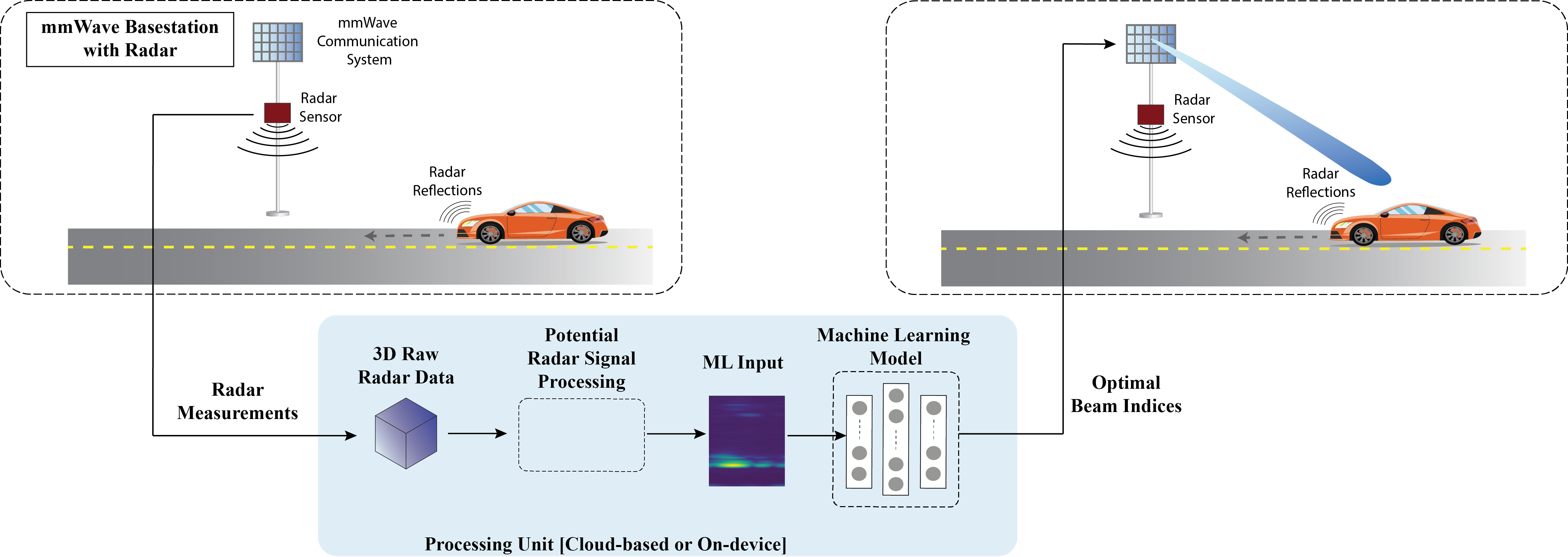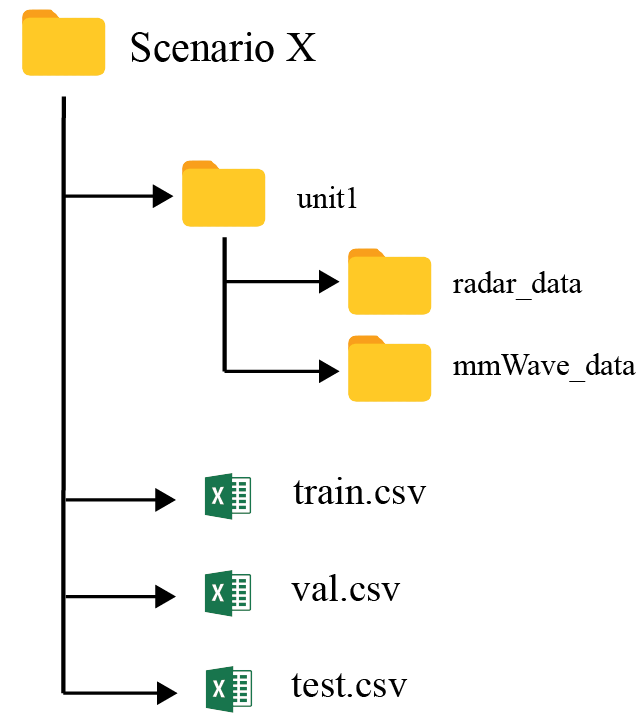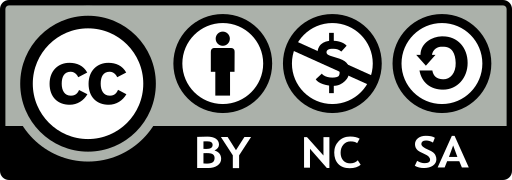Radar-Aided Beam Prediction
Leaderboard
| Date | Name | Approach | Scenario 9 | Paper |
|---|---|---|---|---|
| 1/15/2021 | Wireless Intelligence Lab ASU | Range-Angle + ML | Top-1: 45.35% / Top-3: 80.56% / Top-5: 92.68% | Link |
- This table documents the different radar-aided beam prediction solutions and provides a way for benchmarking.
- For the individual DeepSense scenarios (development datasets), we use the “Top-k” beam prediction accuracy as the evaluation metric.
- For further details and information regarding the ML challenge and how to participate, please check the “ML Challenge” section below.
License
A. Alkhateeb, G. Charan, T. Osman, A. Hredzak, J. Morais, U. Demirhan, and N. Srinivas, “DeepSense 6G: A Large-Scale Real-World Multi-Modal Sensing and Communication Datasets,” IEEE Communications Magazine, 2023.
@Article{DeepSense,
author={Alkhateeb, Ahmed and Charan, Gouranga and Osman, Tawfik and Hredzak, Andrew and Morais, Joao and Demirhan, Umut and Srinivas, Nikhil},
title={DeepSense 6G: A Large-Scale Real-World Multi-Modal Sensing and Communication Dataset},
journal={IEEE Communications Magazine},
year={2023},
publisher={IEEE}}
U. Demirhan and A. Alkhateeb, “Radar Aided 6G Beam Prediction: Deep Learning Algorithms and Real-World Demonstration,” 2022 IEEE Wireless Communications and Networking Conference (WCNC), 2022, pp. 2655-2660, doi: 10.1109/WCNC51071.2022.9771564.
@INPROCEEDINGS{Demirhan2022beam,
author = {Demirhan, Umut and Alkhateeb, Ahmed},
booktitle = {2022 IEEE Wireless Communications and Networking Conference (WCNC)},
title = {Radar Aided {6G} Beam Prediction: Deep Learning Algorithms and Real-World Demonstration},
year = {2022},
pages = {2655-2660},
doi = {10.1109/WCNC51071.2022.9771564},}
Introduction
Beam selection is a challenge: Millimeter-wave (mmWave) and sub-terahertz (sub-THz) communications are key pillars for current and future wireless communication networks. The large available bandwidth at the high frequency bands enables these systems to satisfy the increasing data rate demands of the emerging applications in autonomous driving, edge computing, mixed-reality, etc. These systems, however, require deploying large antenna arrays at the transmitters and/or receivers and using narrow beams to guarantee sufficient receiver power. Finding the best beams (out of a codebook) at the transmitter and receiver is associated with high beam training overhead (search time to find/align the best beams), which makes it hard for these systems to support highly-mobile and latency-sensitive applications.
Sensing aided beam prediction is a promising solution: The dependence of mmWave/sub-THz communication systems on the line-of-sight links between the transmitter/receiver means that the awareness about their locations and the surrounding environment (geometry of the buildings, moving scatterers, etc.) could potentially help the beam selection process. For example, the sensory data collected by RGB cameras, LiDARs, Radars, GPS receivers, etc., can enable the transmitter/receive decide on where to point their beams (or at least narrow down the candidate beam steering directions). We call this approach sensing-aided beam prediction/selection. Radar-aided beam prediction is a special case when the transmitter/receiver attempt to leverage radar measurements of the environment, captured by a radar device, to predict their optimal beam indices.

Radar-aided beam prediction: Specific Task Description
Radar-aided beam prediction at the infrastructure is the task of predicting the optimal beam indices from a pre-defined codebook by utilizing a machine learning model and the radar data of the wireless environment captured by the radar installed at the basestation.
Objective of the ML Task: Given an radar data of the environment captured (by the basestation) at any time step t, the primary objective of this task is to design a machine learning model that predicts the optimal beam index. From the wireless communication perspective, the machine learning model aims to return the index of the beam (from a pre-defined codebook) that maximizes the received signal-to-noise ratio (SNR). In general, the machine learning model is expected to return the ordered set of ‘K’ most likely beams , i.e., the top-K beams. For ML model development, we provide a labeled dataset consisting of raw radar data (may be pre-processed before being fed to the ML model) and the ground-truth beam indices (labels). More details regarding the dataset is provided in the Dataset section below.
For further information regarding how radar can aid the beam prediction task, please refer to our paper:
Task-Specific Dataset
DeepSense 6G: Developing efficient solutions for sensing-aided beam prediction and accurately evaluating them requires the availability of a large-scale real-world dataset. With this motivation, we built the DeepSense 6G dataset, the first large-scale real-world multi-modal dataset with co-existing communication and sensing data.
In this radar-aided beam prediction task, we build development/challenge datasets based on the DeepSense data from scenarios [9].
For each scenario, we provide the following datasets:
- Development Dataset: It comprises the 3D complex raw FMCW radar data and the corresponding 64×1 power vectors obtained by performing beam training with a 64-beam codebook at the receiver (with omni-transmission at the transmitter). The radar data comprises of the radar measurements of the wireless environment captured by the FMCW radar installed at the basestation. The dataset also provides the optimal beam indices as the ground-truth labels.
- Challenge Dataset: To motivate the development of efficient ML models, we propose a benchmark challenge. For this, we provide a Challenge dataset, consisting of only the input radar measurements. The ground-truth labels are hidden from the users by design to promote a fair benchmarking process. To participate in this Challenge, check the ML Challenge section below for further details.
Below we explain how to access the development dataset.
Please login to download the DeepSense datasets
How to Access Task Data?
Step 1. Download All Scenarios Dataset
Step 2. Extract the RABT.zip file. Contains the scenario dataset folders
Each scenario folder consists of following files:
- unit1:
- radar_data: 3D Complex FMCW radar observations
- mmWave_data: Beam power level measurements
- train.csv
- val.csv
- test.csv

What does each CSV file contain?
For each data collection sampling time (~100ms), we provide the corresponding radar and wireless data. Further, we compute the ground-truth beam indices from the power vectors and provide them under the “beam_index” column. An example of 5 data samples in shown below.
ML Challenge: Radar-Aided Beam Prediction
To advance the state-of-the-art in the radar-aided beam prediction task, we propose a benchmark challenge based on the DeepSense real-world dataset. The objective of the task is to develop a machine learning solution that takes the radar measurements captured at the basestation as the input, potentially processes it with signal processing, and predicts the optimal beam indices via machine learning for the served mobile user.
This challenge adopts the labeled development dataset described above with radar measurements and the corresponding optimal beams.
Participation Steps
Step 1. Getting started: First, we recommend the following:
- Get familiarized with the data collection testbed and the different sensor modalities presented here
- Next, in the Tutorials page, we have provided Python-based codes to load and visualize the different data modalities
Step 4. Submission: After you develop your ML model, you are invited to submit your results at submission@DeepSense6G.net. Please find the submission process and evaluation criteria below.
Submission Process
We define a standardized beam prediction result format that serves as an input to our evaluation code. There a single real-world DeepSense 6G scenarios in this challenge. For each scenario, please submit the following:
- The users must submit the Top-3 predicted beams for the Challenge set. An sample submission csv file is shown below.
- Every submission should provide their pre-trained models, evaluation code and ReadMe file documenting the requirements to run the code.ple
| sample_index | top-1 beam | top-2 beams | top-3 beams |
|---|---|---|---|
| 1 | 5 | [5,7] | [3,5,7] |
| 2 | 21 | [21,23] | [21,23,24] |
| 3 | 62 | [62,59] | [62,59,61] |
| 4 | 49 | [49,50] | [49,50,37] |
| 5 | 12 | [12, 14] | [12, 14, 15] |
Evaluation
- The evaluation metric adopted in this challenge is the top-k beam prediction accuracy.
- The top-k accuracy is defined as the percentage of test samples whose ground-truth beam index lies in the predicted beam of top-k scores.
- The evaluation is done based on the ML challenge (hidden) test set, which is used for benchmarking purposes.
Leaderboard Rules
- In order to be ranked in the Leaderboard above, please submit your results following the submission process above
- Further, to be ranked in the Leaderboard table, contestants need to submit the challenge set results for all the 5 scenarios.

